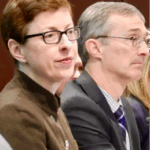60 Years of Medicaid: The People Who Make It Work
Every day, NAMD is witness to all that these amazing people bring to their programs. They and their predecessors have led Medicaid through its first 60 years, and they will continue to advance its next chapter.
Author
- Kate McEvoy
Focus Areas
As we acknowledge and honor the 60th anniversary of the Medicaid program, you might think that my most meaningful memories of having served as a Medicaid director focus on how the program helped people improve their health and financial security. So many experiences of that kind are top of mind for me, but I particularly think of a young man whose Medicaid-funded services helped him become employed and to live independently in an apartment. These experiences then gave him the confidence to mentor peers and their parents in making their own way toward those goals. Medicaid truly helped to create incredible new possibilities for all of them. I also think about all of the people who gained access to curative hepatitis C drugs, helping them to avoid the terrible, costly outcomes that are associated with chronic liver disease. We are at another moment in time at which a major advance in curing chronic conditions is becoming possible through cell and gene therapy.
And finally, I reflect on a woman, with whom I am still connected, who is in recovery for substance use disorder and now provides peer support to people who are getting treatment.
I know that all of the current Medicaid directors and their teams also draw a lot of inspiration from these experiences. Alongside these important stories of impact for people, however, I also want to call out the many people whose careers as civil servants are devoted to improving the performance and efficiency of the program. These individuals work tirelessly behind the scenes to make the Medicaid program a reality. Their mission-focus, tenacity, pragmatism, and creativity helps to ensure that Medicaid is always delivering high value to members and to taxpayers.
I had the opportunity to work with so many of that kind of people when I served in Connecticut. Just one stand-out among them is Mike Gilbert, the Chief Financial Officer with whom I served. I used to say, however unfairly to finance folks, that Mike was an amazing financial steward who also thought like a policy person. When Connecticut embarked on a major transformation of our Medicaid delivery model, Mike did visionary work around creating a framework of indicators – including our per capita spending, administrative rate and share of the state budget – that helped us as well as our governor and legislative leadership track our program’s financial health, compare our performance with peer states, and course correct if things weren’t lining up with our strategic goals. An important, non-exclusive example of this is whether we were succeeding in serving more older adults and people with disabilities in the community, where folks report they prefer to live, than in costlier institutional settings.

We presented these “pillars” to our Medicaid advisory council at the top of each legislative session. This equipped them to provide informed feedback and to develop recommendations around appropriations and proposed legislation as well as administrative actions that we could take.
Directors also rely on key members of their teams to ensure that a complicated program runs effectively and accountably. In the same way I partnered with Mike, Lisa Lee, who is the director of the Kentucky Medicaid program looks to her CFO Steve Bechtel to develop financial projections and performance indicators for the program, oversee claiming for federal reimbursement, and ensure program integrity. And this certainly isn’t unique to the financial aspects of the program. In Louisiana, director Kim Sullivan works with her Chief Information Officer Mitzi Hochheiser to carefully articulate systems needs and procurements, as well as to build in agile strategies that are making those processes more timely and successful. And New Mexico Medicaid’s lead communicator, Heidi Capriotti, is someone on whom director Dana Flannery relies around member and provider engagement.
NAMD has had the great privilege over recent years in building on its longstanding commitment to state and territory Medicaid directors by supporting many additional senior members of their teams through NAMD’s affinity groups. We support these individuals in creating connection and community, sharing technical expertise and comparing notes on locally relevant best practices. The affinity groups, which include nationwide membership, serve chief financial officers, eligibility leaders, chief information officers and communicators.
Every day, NAMD is witness to all that these amazing people bring to their programs. They and their predecessors have led Medicaid through its first 60 years, and they will continue to advance its next chapter.
To each and every member of the state and territory Medicaid teams: we are deeply proud to work with and for you. You do right by the program and give civil service a great name.
Related resources
Elevating Community Voice in Shaping Medicaid Priorities
Stay Informed
Drop us your email and we’ll keep you up-to-date on Medicaid issues.